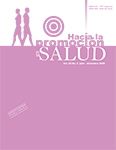Authors
Abstract
The COVID-19 pandemic, caused by a new type of coronavirus called SARS-CoV2, is an acute infection of the respiratory tract (1, 2) that has spread to more than 200 countries, leaving a fatal toll of more than 4,200 .000 infected and nearly 300,000 deaths, from their appearance in December 2019 to the beginning of May 2020. In Colombia, during that period, more than 13,000 infected and 500 deaths have been counted (3). Due to its rapid spread and high transmission rate, mitigation measures such as quarantine (social distancing), protection barriers (masks, suits, glasses) and physical distancing (keeping 2 m between person and person) have been adopted. Since there is evidence that SARSCoV2 remains active for up to 3 hours in aerosols, 4 hours on copper surfaces, 24 hours on cardboard, 48 hours on stainless steel and 72 hours on plastic (2), one of the challenges in the fight against COVID-19 is to find effective cleaning mechanisms for surfaces, structures and aerosols.
Keywords:
References
2. Van Doremalen N, Bushmaker T, Morris DH, Holbrook MG, Gamble A, Williamson BN, et al.Aerosol and Surface Stability of SARS-CoV-2 as Compared with SARS-CoV-1 [Internet]. The NewEngland Journal of Medicine. 2020. p. 1-4. Disponible en: https://www.nejm.org/doi/full/10.1056/NEJMc2004973
3. Ministerio de Salud de Colombia. Reporte Mundial Covid-19 [Internet]. 2020 [citado 11 de mayo de 2020]. Disponible en: https://twitter.com/MinSaludCol/status/1259613324955783168
4. Kampf G, Todt D, Pfaender S, Steinmann E. Persistence of coronaviruses on inanimate surfaces and their inactivation with biocidal agents. J Hosp Infect [Internet]. 2020; 104(3):246-51. Disponible en: https://www.journalofhospitalinfection.com/article/S0195-6701(20)30046-3/fulltext
5. International Ultraviolet Association (UVA). IUVA Fact Sheet on UV Disinfection for COVID-19 [Internet]. 2020 [citado 13 de mayo de 2020]. Disponible en: http://www.iuva.org/resources/IUVA_Fact_Sheet_on_COVID_19.pdf
6. Welch D, Buonanno M, Grilj V, Shuryak I, Crickmore C, Bigelow AW, et al. Far-UVC light: A new tool to control the spread of airborne-mediated microbial diseases. Sci Rep [Internet]. 2018; 8(1):1-7. Disponible en: https://www.nature.com/articles/s41598-018-21058-w
7. Buonanno M, Welch D, Shuryak I, Brenner DJ. Far-UVC light efficiently and safely inactivates airborne human coronaviruses. Res Sq [Internet]. 2020; Disponible en: https://www.researchsquare.com/article/rs-25728/latest?utm_source=researcher_app&utm_medium=referral&utm_campaign=RESR_MRKT_Researcher_inbound
8. Theory Division CCLRI, Card KJ, Crozier D, Dhawan A, Dinh M, Dolson E, et al. UV Sterilization of Personal Protective Equipment with Idle Laboratory Biosafety Cabinets During the Covid-19 Pandemic. medRxiv [Internet]. 2020;2020.03.25.20043489. Disponible en: https://www.medrxiv.org/content/10.1101/2020.03.25.20043489v1%0Ainternal-pdf://0.0.23.4/2020.03.25.html
9. Nave R. The interaction of radiation with matter [Internet]. Giorgia State University. 2001 [citado 13 de mayo de 2020]. p. 1-5. Disponible en: http://hyperphysics.phy-astr.gsu.edu/hbase/mod3.html
10. Cantor C. Could a New Ultraviolet Technology Fight the Spread of Coronavirus? Columbia News [Internet]. abril de 2020; 1. Disponible en: https://news.columbia.edu/ultraviolet-technology-viruscovid-19-UV-light

 PDF (Español)
PDF (Español)
 FLIP
FLIP
 Perfil Google Scholar
Perfil Google Scholar























